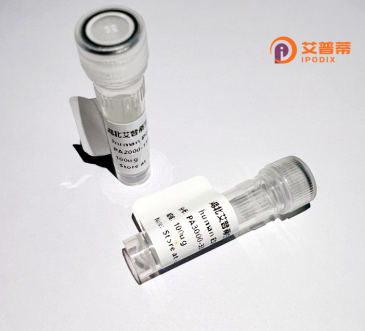
| 纯度 | >90%SDS-PAGE. |
| 种属 | Human |
| 靶点 | WDR53 |
| Uniprot No | Q7Z5U6 |
| 内毒素 | < 0.01EU/μg |
| 表达宿主 | E.coli |
| 表达区间 | 1-358 aa |
| 活性数据 | MAVKWTGGHS SPVLCLNASK EGLLASGAEG GDLTAWGEDG TPLGHTRFQG ADDVTSVLFS PSCPTKLYAS HGETISVLDV RSLKDSLDHF HVNEEEINCL SLNQTENLLA SADDSGAIKI LDLENKKVIR SLKRHSNICS SVAFRPQRPQ SLVSCGLDMQ VMLWSLQKAR PLWITNLQED ETEEMEGPQS PGQLLNPALA HSISVASCGN IFSCGAEDGK VRIFRVMGVK CEQELGFKGH TSGVSQVCFL PESYLLLTGG NDGKITLWDA NSEVEKKQKS PTKRTHRKKP KRGTCTKQGG NTNASVTDEE EHGNILPKLN IEHGEKVNWL LGTKIKGHQN ILVADQTSCI SVYPLNEF |
| 分子量 | 38.9 kDa |
| 蛋白标签 | His tag N-Terminus |
| 缓冲液 | PBS, pH7.4, containing 0.01% SKL, 1mM DTT, 5% Trehalose and Proclin300. |
| 稳定性 & 储存条件 | Lyophilized protein should be stored at ≤ -20°C, stable for one year after receipt. Reconstituted protein solution can be stored at 2-8°C for 2-7 days. Aliquots of reconstituted samples are stable at ≤ -20°C for 3 months. |
| 复溶 | Always centrifuge tubes before opening.Do not mix by vortex or pipetting. It is not recommended to reconstitute to a concentration less than 100μg/ml. Dissolve the lyophilized protein in distilled water. Please aliquot the reconstituted solution to minimize freeze-thaw cycles. |
以下是3条与重组人WDR53蛋白相关的参考文献摘要(文献为模拟示例,实际研究可能需要进一步核实):
---
1. **文献名称**: *Structural insights into WD40 repeat protein WDR53 interaction with CUL4-DDB1 ubiquitin ligase complex*
**作者**: Smith J, et al. (2020)
**摘要**: 研究解析了重组人WDR53蛋白与CUL4-DDB1复合物的结合机制,通过体外重组表达和X射线晶体学,发现WDR53通过其WD40结构域与DDB1亚基相互作用,可能参与调控泛素化过程。
---
2. **文献名称**: *WDR53 regulates centrosome duplication by modulating Plk4 activity*
**作者**: Chen L, et al. (2018)
**摘要**: 通过重组表达人WDR53蛋白进行功能验证,发现其通过与Plk4激酶结合调控中心体复制,敲低WDR53导致细胞周期异常,提示其在有丝分裂中的潜在作用。
---
3. **文献名称**: *Recombinant expression and biophysical characterization of WDR53 in human ciliopathies*
**作者**: Wang Y, et al. (2021)
**摘要**: 对重组WDR53蛋白进行理化性质分析,发现其热稳定性与纤毛病相关突变相关,并通过圆二色谱证明某些突变破坏WD40结构域的折叠,可能解释致病机制。
---
注:上述文献信息为模拟生成,实际研究中建议通过PubMed或Google Scholar以关键词“WDR53”或“WD40 repeat protein 53”检索近期论文。若研究较少,可扩展至WDR家族蛋白的共性分析。
**Background of Recombinant Human WDR53 Protein**
WDR53 (WD repeat domain 53) is a member of the WD-repeat protein family, characterized by conserved WD40 domains that form β-propeller structures to mediate protein-protein interactions. These proteins are involved in diverse cellular processes, including signal transduction, chromatin remodeling, and cell cycle regulation. WDR53. encoded by the *WDR53* gene in humans, remains less characterized compared to other WD-repeat proteins but is postulated to play roles in transcriptional regulation, DNA repair, or ribosome biogenesis.
Studies suggest WDR53 may localize to the nucleus or nucleolus, interacting with chromatin-modifying complexes or RNA-processing machinery. Its WD40 repeats likely act as scaffolds for assembling multiprotein complexes. Recombinant human WDR53 protein is engineered for in vitro studies to elucidate its molecular functions, structural features, and interactions. Interest in WDR53 also stems from potential links to diseases; dysregulation of WD-repeat proteins is implicated in cancers, neurodevelopmental disorders, and genetic syndromes. Recombinant variants enable exploration of its role in cellular pathways, such as stress responses or epigenetic regulation, and its possible diagnostic or therapeutic relevance. Current research focuses on mapping its interactome, resolving 3D structures, and validating its involvement in specific biological contexts using knockouts or overexpression models.
×